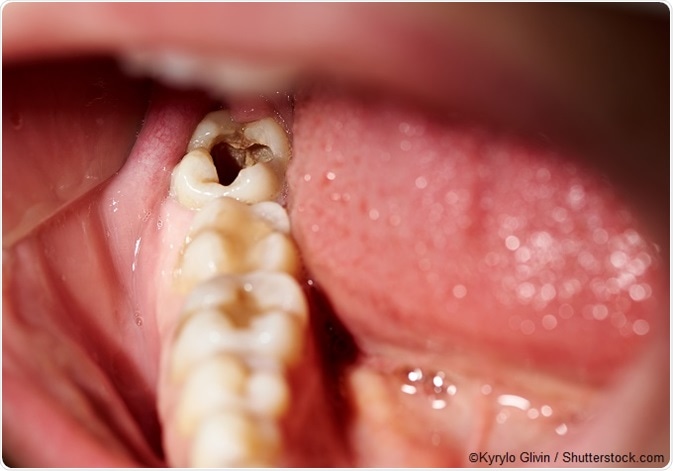Treatment and Prevention of Tooth Decay
Although the early stages of tooth decay are amenable to treatment, the advanced stages may lead to tooth loss along with a host of other complications. The basic tenet for treating tooth decay is therefore early identification of the problem, when the tooth can still be salvaged.

In the early stages of tooth decay, for example, a simple fluoride varnish applied to the affected area may be enough to treat the condition. In addition, lifestyle measures can also be taken that can prevent further decay. In the more advanced stages, where cavities have formed, the decay is removed and the tooth may be filled with a filling or set with a crown. In cases where the inner nerves are exposed and causing severe pain, a root canal treatment is recommended. An excessively damaged tooth may have to be operated on or removed.
Treatment
Treatment of tooth decay may include:
- Fluoride in early stages of tooth decay – This is one of the most effective ways of preventing and limiting the spread of tooth decay. Fluoride occurs naturally in tea, certain fish and in some foods and is often supplemented in toothpastes. Toothpastes containing synthetic fluoride are one of the best sources of fluoride. Fluoride can help strengthen the tooth enamel and protect it against the acid erosion that leads to decay. Furthermore, fluoride prevents the formation of plaque and the production of bacterial acids. In the early stages of tooth decay, fluoride can also repair damaged enamel. Fluoride may be applied over the affected tooth in the form of a fluoride gel, varnish or paste.
- Filling of cavities – When cavities form in the enamel without affecting the inner pulp of the tooth, a dental filling may be used. The filling acts as a replacement for the natural enamel of the tooth. It can be made of amalgam, which is silver in color or of a tooth colored composite. The filling is sealed onto the tooth using dental cement. Inlays and onlays made of harder and longer lasting metals such as gold may also be used to fill cavities.
- Artificial tooth crowns – Another method of treating teeth with cavities is fitting them with an artificial tooth crown. The decayed part of the tooth is drilled off and a crown the shape of the original tooth is placed over the remaining tooth. This crown may be made up of porcelain, ceramic, gold or glass and is attached to the tooth with dental cement.
- Root canal treatment – This is one of the last resorts to save the tooth. Root canal treatment is indicated when the inner pulp of the tooth containing the nerves and blood vessels are affected, causing intense pain on exposure to hot or cold food or drink. In root canal treatment, the pulp is removed and replaced with an artificial pulp called gutta percha.
- Removal of the tooth – Severely damaged and decayed teeth may require extraction, especially to prevent complications such as the spread of decay to other teeth. The removed tooth may be replaced with an artificial partial denture, dental bridge or tooth implant to maintain cosmetic appearance.
Prevention of tooth decay
Tooth decay is one of the most common conditions to affect children and adults worldwide but it is also one of the most easily preventable. Some of the preventive measures for tooth decay include:
Maintaining good oral hygiene
Teeth should be brushed twice daily (once in the morning and once at bedtime) with a fluoride toothpaste. Brushing should follow within at least 30 minutes of eating a meal, especially if it rich in sugar and carbohydrates. Brushing should be thorough, covering all surfaces of the teeth. Mouth rinsing after brushing is discouraged as it washes away the fluoride of the paste. Instead, the excess paste should be spat out. The toothbrush should be replaced on a regular basis (every two to three months) as it may become less effective at removing plaque as it wears out.
Flossing helps to remove plaque and food particles that get stuck between teeth, areas that the toothbrush fails to reach. Flossing at least once a day is recommended.
Mouthwash
Dental mouthwashes, especially ones containing fluoride, can also help prevent tooth decay. However, the mouth should not be rinsed immediately after the mouthwash is used, so as to preserve the fluoride across the teeth.
Diet and lifestyle
Consumption of excess sugary foods, fizzy drinks, and chocolates, for example, can accelerate tooth decay. Smoking is also associated with tooth decay. Diet and lifestyle changes along with good oral hygiene can keep tooth decay at bay.
Regular dental checkups
Adults should have at least one dental check-up every two years. Those under 18 years of age need annual check-ups while younger children benefit from check-ups every 4 to 6 months.
Sources
- http://www.nhs.uk/conditions/Dental-decay/Pages/Introduction.aspx
- http://www.ada.org/sections/scienceAndResearch/pdfs/patient_13.pdf
- http://www.stcyrdds.com/pdf/toothdecay.pdf
- http://www.chelsea.co.nz/uploadGallery/sugar-and-dental-health.pdf
- http://www.sign.ac.uk/pdf/sign83.pdf
- http://www.cdc.gov/healthywater/hygiene/disease/dental_caries.html
- http://www.dh.gov.hk/english/pub_rec/pub_rec_lpoi/files/ohse1.pdf
Further Reading
- All Tooth Decay Content
- What is Tooth Decay?
- Causes of Tooth Decay
- Symptoms and Diagnosis of Tooth Decay
- Complications of Tooth Decay
Last Updated: Feb 27, 2019

Written by
Dr. Ananya Mandal
Dr. Ananya Mandal is a doctor by profession, lecturer by vocation and a medical writer by passion. She specialized in Clinical Pharmacology after her bachelor's (MBBS). For her, health communication is not just writing complicated reviews for professionals but making medical knowledge understandable and available to the general public as well.
Source: Read Full Article
